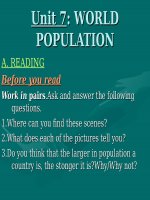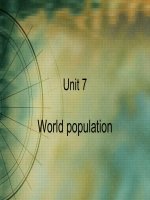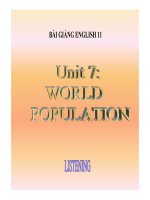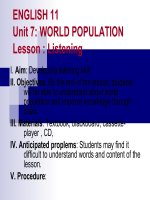Unit 7. World population
Bạn đang xem bản rút gọn của tài liệu. Xem và tải ngay bản đầy đủ của tài liệu tại đây (1.81 MB, 31 trang )
Unit 7:
WORLD POPULATION
According to UNFP, world population now is 7,2 billion. In
Vietnam, it is about 84 million.
What do these pictures tell you?
They tell us that we are facing overpopulation
TION
A
L
U
P
PO
D
L
R
O
it 7: W
I.
BEFORE YOU READ:
•
Look at the picture given in your textbook and answer the
following question.
1. BEFORE YOU READ:
1.
2.
Where can you find the scenes?
What does each of the pictures
tell you?
3.
Do you think that the larger in
population a country is, the
stronger it is? Why/ Why not?
Unit 7 :
WORLD POPULATION
I. NEW WORDS :
to increase:
Gia tăng
≠ to decrease: giảm
Unit 7 :
to raise animals:
WORLD POPULATION
nuôi động vật
Unit 7 :
family planning:
kế hoạch hóa gia đình
WORLD POPULATION
Unit 7 :
200
WORLD POPULATION
400
to double:
Third World :
gấp đôi
Thế Giới Thứ 3
B.C: Before Christ: tröôùc coâng nguyeân
Unit 7 :
WORLD POPULATION
- Increase (v) : tăng
- Decrease (v):
giảm
- raise animals (v phr):
nuôi động vật
- Double (v): gaáp ñoâi
- Third World (n phr):
thế giới thứ ba
- Family planning (n phr) :
kế hoạch hóa gia đình
- Figure (n) : con số
- Resource (n) : nguồn tài nguyên
- Method (n) : biện pháp
- B.C: Before Christ (n phr): tröôùc coâng nguyeân
2. WHILE YOU READ:
The population of the world has been increasing faster and faster. In 10,000 BC., there were probably only 10 million
people. In A.D. 1, there were 300 million. It took 1,750 years for the world population to reach 625 million. In 1850, only
100 years later, the population reach the figure of 1,300 million. In 1950, the figure had more than doubled to reach
2,510 million. In 1985, only 35 years later, there were 4,760 million people. In 2000, the world’s population was about
6,6 billion, and by 2015 it is expected to be over 7 billion.
Does the earth have enough resources to support this many people? Different scientists give different answers to this
question. Some say that there are enough resources to support 8 billion people. Other say that we must limit
population growth because our resources are limited. Only 10 percent of the earth’s land can be used for farming and
another 20 percent for raising animals. There is a limit to the water we can use. There are also limits to the amounts of
petroleum, iron, silver, gold, and other metals.
Research has show that the average Third World woman has more children than she wants. Among the women who do
not think they have too many children, half of them do not want any more. However, although millions of women want
to limit the size of their families, they know of no safe way to have fewer children. Safe birth – control methods for
family planning are not available to them. It is time governments and international organizations did something to help
them so that the world population growth can to decrease instead of continuing to increase.
Task 1
The words in the box all appear in the passage. Fill in each blank with a suitable word.
limit
control
(v, n)
(v, n)
figures
increases
(n)
method
(v)
Although
(n)
international
(adj)
resources
1. _______ most journalists studied journalism in college, some older writers never attended a university.
2.Can you explain the ________ for changing salt water to fresh water?
3.The number of injuries from automobile accidents________ every year.
4.Some countries are poor because they have very few natural_______
5.These are all ________: 1, 75, 293.
6. There is a(n) _______of 20 minutes for this short test. Students must turn in their papers at the end of 20
7. The United Nations is a(n)_______________ organization.
8. Some children behave badly and their parents can’t___________them.
th
minute.
(n)
2
K
S
TA
Answer the questions on the passage
1. What was the population of the world in 10,000 B.C., 1750, 1850, 1950, 1985, and
2000?
2. How many people is the world expected to have by the year 2015?
3. Can the Earth have enough resources to support its population?
4. Do most Third World women want to have a lots of children?
5. Why can’t women in the world limit the size of their family?
UNIT 7 : POPULATION
LESSON 1: READING
TASK 2: ANSWER KEYS
1. What was the population of the world in 10,000 B.C., 1750, 1850, 1950,
1985, and 2000?
The world population in 10,000 B.C. is 10 million; 1750: 625 million;
1850: 1300 million; 1950: 2510 million; 1985: 4760 million; 2000: about
6,6 billion.
2. How many people is the world expected to have by the year
2015?
By the year 2015 it is expected to be over 7 billion.
Complete the chart
people
m = million / b = billion
year
0 10,000B.C AD1
1750 1850
1950
1985 2000 2015
UNIT 7 : POPULATION
LESSON 1: READING
TASK 2: ANSWER KEYS
3. Can the Earth have enough resources to support its population?
Some
scientists say it can, but others say it can’t.
UNIT 7 : POPULATION
LESSON 1: READING
TASK 2: ANSWER KEYS
4. Do most Third World women want to have a lots of children?
No,
they don’t. most of them have more children than they
want.
5. Why can’t women in the world limit the size of their family?
They
can’t limit the size of their family because they know of
no safe way to have fewer children.
The Big Wheel
Play
Team Scores
The Big Wheel
100
Team One
125
Team Two
Question 1
Question 2
Question 3
Question 4
Question 5
Question 6
Spin Wheel
Points
The Big Wheel
1. In 1750 the world population was 625
million.
T
/F
The Big Wheel
2. All scientists agree that the earth has enough
resources to support all of the people.
T /F
Some scientists ….
The Big Wheel
20
3. We can use ….. percent of the earth’s land to raise
animals.
The Big Wheel
4.What are resources also limit?
There are also limits to the amounts of petroleum, iron, silver,
gold , and other metals









